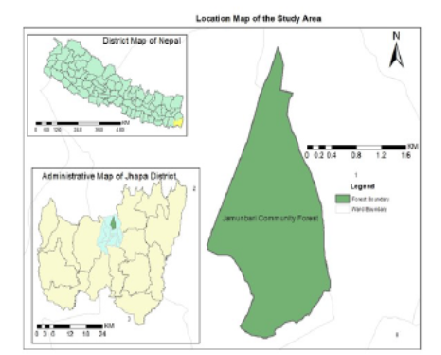


Indian Journal of Science and Technology
Year: 2024, Volume: 17, Issue: 28, Pages: 2880-2888
Original Article
Sushila Rijal1∗, Sutinee Sinutok1
1Faculty of Environmental Management, Prince of Songkla University, HatYai, 90110, Thailand
*Corresponding Author
Email: [email protected]
Received Date:10 March 2024, Accepted Date:07 May 2024, Published Date:20 July 2024
Objectives: This study attempted to explore the effectiveness of community forest (CF) management as an ecosystem based adaptation (EbA) strategy in combating and adapting with the climate change impacts upon local ecosystems and communities. Method: In order to identify EbA options, effectiveness, efficiency, sustainability, governance and socioeconomic function of CF were analyzed. Effectiveness and sustainability were examined and compared through Land Use Land Cover (LULC) database during 1996 and 2021. Efficiency was explored through the economic valuation of provisioning and cultural services, using economic approach–revealed price (market price) method. Socioeconomic functions and governance were examined through the existing plans/policies and secondary data review. Findings: CF is effectively and sustainably managing the available resources. It has increased forest cover, water body, grassland and remarkable decline in bush and sand area. Bush area (79.25 ha in 1996) dropped (to 6.52 ha in 2021) while forest cover increased from 340.46 ha to 375.54 ha. Waterbody (pond or lake area) was limited to 0.88 ha that expanded to 5.04 ha in 2021 due to the conservation oriented management practices. Meanwhile, economic value of provisioning services is USD 7182 accounting wood and timber the highest (average annual USD 4800) among the provisioning services while average annual value of firewood and poles is USD 1367 and NTFP (fish and rubber) is USD 1015 whereas the economic value of cultural services is USD 18803. Novelty: The novelty of the research work lies in the unique methodology and the selection of CF for the EbA case study, which is least explored. By exposing the integration of ecological and socio-economic considerations, this research underscores the significance CF as EbA option in shaping sustainable development pathway in Nepalese context.
Keywords: Ecosystem Services, Ecosystem Based Adaptation, Community Forest, Nepal, Land Management
© 2024 Rijal & Sinutok. This is an open-access article distributed under the terms of the Creative Commons Attribution License, which permits unrestricted use, distribution, and reproduction in any medium, provided the original author and source are credited. Published By Indian Society for Education and Environment (iSee)
Subscribe now for latest articles and news.